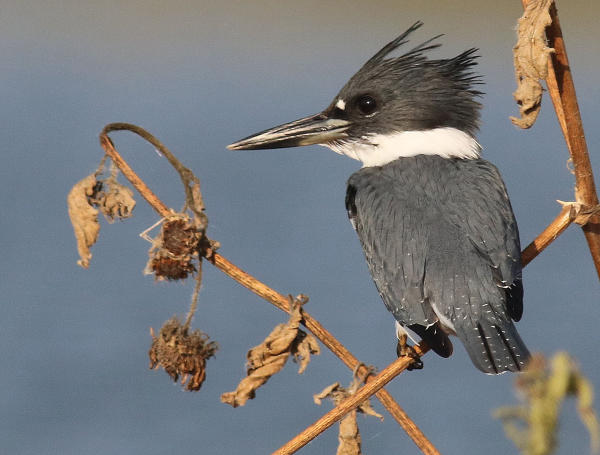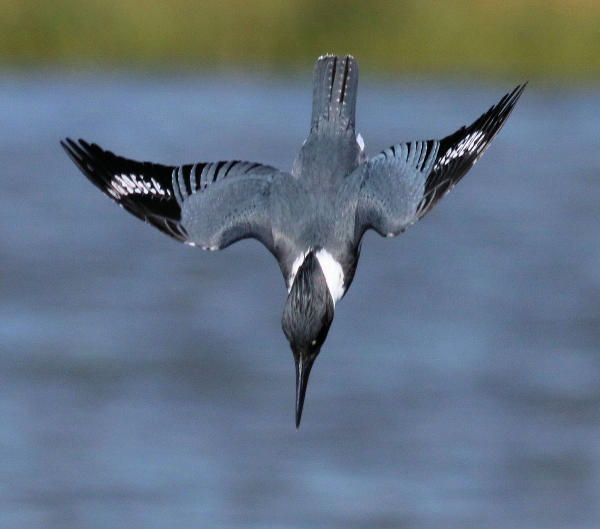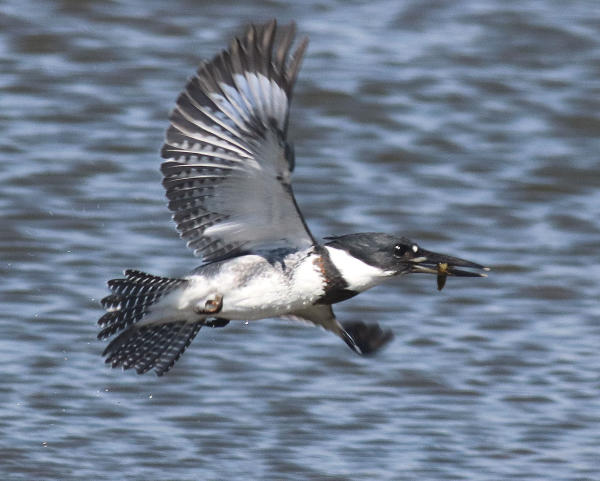
Kingfishers are wary birds that have only provided a few fleeting photo opportunities over the years. That changed when I found a male Belted Kingfisher that permitted me to spend time with it repeatedly during a fun August week while it hunted and “fished” and caught prey on the edge of a shallow wetland. From a variety of perches, the hunter/fisher watched for the movement of potential food on and below the water surface – large grasshoppers on the water; small fish underwater.
The grasshoppers inadvertently took flights over the water, landing on the surface to become stranded afloat and unable to jump or take flight again. The kingfisher reacted as soon as a grasshopper hit the water, launching downward from its elevated perch using gravity and rapid wingbeats to zip to the location and snatch the insect from the water, barely missing a wingbeat, and returning to a perch to dispatch and swallow it.
The kingfisher was even more spectacular when diving for small fish, sometimes initiated from a hovering flight, followed by a head-first dive into the pond. Almost instantly the kingfisher reversed direction from the water with a spray of water droplets shed from its rapid wingbeats – sometimes with a fish in its beak, sometimes without. Lots of great action to try to photograph!

One key piece of technology that helps immeasurably while taking action photos is the auto-focus technology of my camera and telephoto lens. This super-tech auto-focus feature can actually track what my eye is focused on through the camera’s viewfinder, and coordinates the connection between the camera and lens to very quickly focus on the bird, and theoretically stay focused on the kingfisher as it flies or dives or hovers or perches.
In reality, automatically focusing on a speeding bird isn’t a 100 percent prospect, because getting that initial visual contact is tough at high-speed, and keeping the lens focused on the twisting-turning, diving or elevating bird is tougher yet. This kind of high-speed photography puts the auto-focus to the ultimate test, and when everything works right, it’s almost magical to see the resulting photos.
Believe it or not, though, the action photos came much easier than a portrait photo. Amid all the photos taken of assaults on small fish and large insects, after the first few days I still didn’t have a good portrait photo, at least not one that didn’t include the powerline wire that the kingfisher preferred to perch on rather than a natural perch.

Then one day, as I drove slowly along the edge of the wetland searching for the kingfisher, I spotted him perched low, just a few feet from my position. By the time I saw it and reacted, my van had passed the kingfisher’s position a bit; so I slowly stopped, shifted my van into reverse, and crossed my fingers that the kingfisher would permit me to back into position for a portrait attempt. He did! I took two quick images, one with his crest raised a bit, before he repositioned to another fishing perch. What luck! Gracias amigo!
A big plus for the portrait photos was the water background at that low angle that was far enough away that it is out of focus, making a very simple and pleasing inert blue background. I couldn’t have planned it better if I had the option to do some planning. Never again did I see the kingfisher perch like that on the edge of the wetland. Be ready, be prepared, be lucky.
My favorite aspect of spending time with a kingfisher is when it calls. When it raises its distinctive crest, tips its tail up and emits its sharp rattling call of the wild that always brings a smile to my face and alerts me to the next opportunity to watch the antics of these interesting blue flying predators, camera in hand.
Article and photographs by Paul Konrad
Share your birding photos and stories at editorstbw2@gmail.com